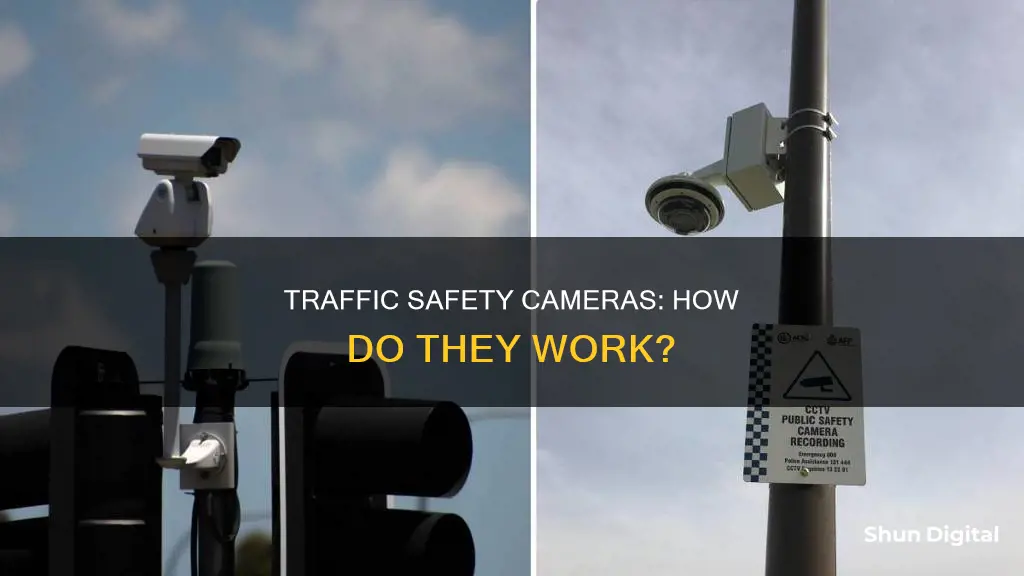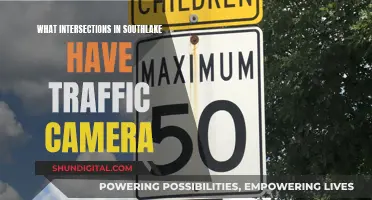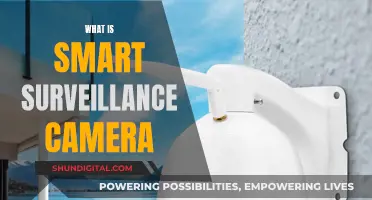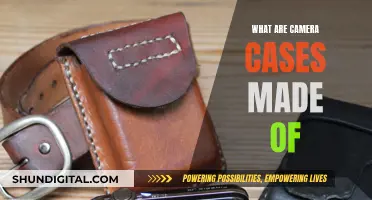
Traffic safety cameras are a type of technology used to monitor and enforce road safety. They are typically mounted on poles or installed in vehicles and are designed to detect and capture evidence of motoring offences such as speeding, running red lights, or unauthorised use of certain lanes. The use of these cameras is often controversial, with some arguing that they invade privacy and are used for government surveillance or revenue collection. However, studies have shown that they can effectively reduce speeding, crashes, and injuries, especially in residential areas, work zones, and school zones.
| Characteristics | Values |
|---|---|
| Purpose | Detecting motoring offences, including speeding, red light running, toll booth avoidance, unauthorised use of bus lanes, recording vehicles inside congestion charge areas, and monitoring traffic flow and determining traffic light timing |
| Type | Traffic enforcement camera, red light camera, speed camera, road safety camera, road rule camera, photo radar, photo enforcement, Gatso, bus lane camera, flash for cash, Safe-T-Cam, No Contact Apprehension Camera |
| Installation | Mounted beside or over a road or installed in an enforcement vehicle |
| Functionality | May be linked to an automated ticketing system |
| Effectiveness | A worldwide review of studies found that speed cameras led to a reduction of "11% to 44% for fatal and serious injury crashes" |
| Privacy Concerns | The latest automatic number-plate recognition systems can be used for the detection of average speeds and raise concerns over loss of privacy and the potential for governments to establish mass surveillance of vehicle movements |
| Legality | Some states, including Minnesota, do not use traffic cameras for tickets |
| Controversy | Red light cameras are extremely controversial as they are automated ticket-issuing systems that are placed at busy intersections |
| Appearance | Red light cameras are usually bulkier and consist of a large camera box and two external flashes, often mounted separately on poles |
| Placement | Red light cameras are typically mounted near busy intersections, while speed cameras are often used on less populated back roads and in residential areas |
| Variants | Fixed speed cameras, mobile speed cameras |
| Detection | Speed cameras use radar technology directed toward one or more lanes on the road |
What You'll Learn
- Traffic safety cameras are used to detect red light violations
- They can also be used to detect speeding violations
- These cameras are placed at busy intersections or on less populated back roads
- There are fixed and mobile types of traffic safety cameras
- The use of these cameras has been shown to reduce crashes and injuries

Traffic safety cameras are used to detect red light violations
Traffic safety cameras are a type of technology that can be used to detect and prevent traffic violations. They are typically mounted on poles or installed in vehicles and are used to monitor traffic and detect violations such as speeding, red-light running, and unauthorised use of certain lanes.
Red light cameras are a type of traffic safety camera that is used to detect and prevent vehicles from running red lights. These cameras are usually placed at busy intersections and are designed to detect when a motorist enters an intersection on a red light. If a violation is detected, the camera will take multiple images of the car, and the driver will receive a ticket in the mail. Red light cameras are often bulkier than other types of traffic cameras and consist of a large camera box with two external flashes, often mounted on separate poles to capture multiple angles.
Red light cameras are controversial because they automatically issue tickets without the presence of a police officer. However, they have been shown to be effective in reducing red light violations and crashes. For example, an IIHS study found that red light cameras reduced the fatal red light running crash rate in large cities by 21% and the rate of all types of fatal crashes at signalised intersections by 14%.
In addition to reducing crashes, red light cameras can also help to modify driver behaviour and encourage compliance with traffic laws. They can also be used in conjunction with other measures such as proper signal timing and engineering measures to further improve road safety.
Overall, while red light cameras may be unpopular with some drivers, they play an important role in enforcing traffic laws and improving safety on the roads.
Are European Cars Camera-Equipped?
You may want to see also

They can also be used to detect speeding violations
Traffic safety cameras are a type of camera that may be mounted beside or over a road or installed in an enforcement vehicle to detect motoring offences. One of the most common types of traffic safety cameras is the speed camera, which can be used to detect speeding violations.
Speed cameras are usually set up near school zones or areas where drivers often exceed the speed limit. They utilise radar equipment that is linked to the camera to detect when a vehicle is exceeding the speed limit. When this happens, the camera is triggered to take a picture of the vehicle, along with recording the speed of the vehicle and the details of the violation, including the date, time, and location, as well as the vehicle's license plate number.
Speed cameras can be either fixed or mobile. Fixed speed cameras are usually mounted on elevated poles at the side of the road and are easy to spot due to their bulky weatherproof enclosures and external flashes. Mobile speed cameras, on the other hand, are more difficult to notice as they are not permanently mounted and can be located on a tripod or inside a van.
The use of speed cameras has been shown to be effective in reducing speeding and improving road safety. Studies have found that speed cameras led to a reduction in fatal and serious injury crashes, with the British Medical Journal recommending wider deployment of these cameras.
The process of issuing speed camera tickets involves someone, typically a police officer, reviewing the photos or video footage to verify the violation. The citation is then mailed to the registered owner of the vehicle, who is presumed to be the driver unless proven otherwise. Fines for speed camera tickets are generally the same as or less than those for an officer-issued ticket, and in some states, camera-issued tickets do not result in traffic violation demerit points.
Charging Your Fujifilm FinePix: A Step-by-Step Guide
You may want to see also

These cameras are placed at busy intersections or on less populated back roads
Traffic safety cameras are an effective way to discourage dangerous driving and enforce road rules. These cameras are usually mounted beside or over a road or installed in an enforcement vehicle. They can be used to detect a range of motoring offences, including speeding, red-light running, toll booth evasion, and unauthorised use of bus lanes.
The placement of these cameras varies depending on the type of offence being targeted and the specific location. For example, red light cameras are typically placed at busy intersections, while speed cameras are often used on less populated back roads and in residential areas where speeding is a concern.
Speed cameras, in particular, have been proven effective at slowing down cars, encouraging safer driving, and reducing crashes and injuries. They are especially popular in work and school zones, as well as for highway safety improvements. By reducing speeding and red-light infractions, officials can also decrease the number of resulting moving violations and traffic injuries.
In addition to fixed speed cameras, which are mounted on elevated poles at the side of the road, there are also mobile speed cameras. These are more challenging to spot as they are not permanently mounted and can be placed on a tripod or inside a van.
The use of traffic safety cameras is regulated, and there are specific requirements for their placement and use. For instance, jurisdictions must install traffic cameras in a way that minimises the impact of the camera flash on drivers, and they must clearly mark camera locations in advance.
Superlife Camera: Live Stream on Your Computer
You may want to see also

There are fixed and mobile types of traffic safety cameras
Traffic safety cameras are cameras that are mounted beside or over a road or installed in an enforcement vehicle to detect and deter motoring offences. They can be used to detect speeding, vehicles going through red lights, vehicles going through a toll booth without paying, the unauthorised use of a bus lane, or for recording vehicles inside a congestion charge area.
Both fixed and mobile speed cameras are used to deter speeding and reduce the number of road crashes.
Understanding Mirror Mode: Camera's Unique Feature
You may want to see also

The use of these cameras has been shown to reduce crashes and injuries
Traffic safety cameras are an effective way to reduce crashes and injuries. They are an essential tool in the effort to improve road safety and decrease crash rates. The use of these cameras has been shown to be highly beneficial in reducing crashes and injuries, and their implementation can have a significant positive impact on road safety.
Speed safety cameras, for example, are designed to detect speeding and capture evidence of vehicles violating speed limits. Studies have shown that speed cameras lead to a significant reduction in crashes and injuries. A worldwide review of studies found that speed cameras reduced fatal and serious injury crashes by 11% to 44%. Similarly, the UK Department for Transport estimated a 22% reduction in personal injury collisions and a 42% decrease in fatalities or serious injuries at camera sites. The British Medical Journal also reported that speed cameras effectively reduced accidents and injuries, recommending wider deployment.
The effectiveness of speed cameras is further supported by a 2010 Cochrane Review, which analysed 28 studies and found that all of them reported a decrease in crashes following the implementation of speed camera programs. The reductions ranged from 8% to 49% for all crashes, with most studies reporting reductions between 14% and 25%. For injury crashes, the decrease was even more pronounced, ranging from 8% to 50%.
Additionally, speed cameras have been found to reduce speeding. All 35 studies included in the Cochrane Review reported a reduction in average speeds after the introduction of speed cameras. The decrease in speeding ranged from an 8% to 70% reduction in the proportion of speeding vehicles, with most countries experiencing reductions between 10% and 35%.
While the impact of speed cameras on reducing crashes and injuries is well-established, there are also other types of traffic safety cameras that contribute to road safety. Red light cameras, for instance, are placed at busy intersections to detect when a motorist enters the intersection on a red light, capturing multiple images of the violation. While these cameras are controversial, they have been shown to reduce the number of vehicles running red lights significantly.
In summary, traffic safety cameras have been proven to reduce crashes and injuries, making them an invaluable tool in enhancing road safety. They help enforce speed limits and reduce dangerous driving behaviours, ultimately leading to fewer accidents and less severe collisions. The evidence strongly suggests that the use of these cameras plays a crucial role in creating safer road environments for everyone.
Testing Camera Battery Chargers: A Step-by-Step Guide
You may want to see also







